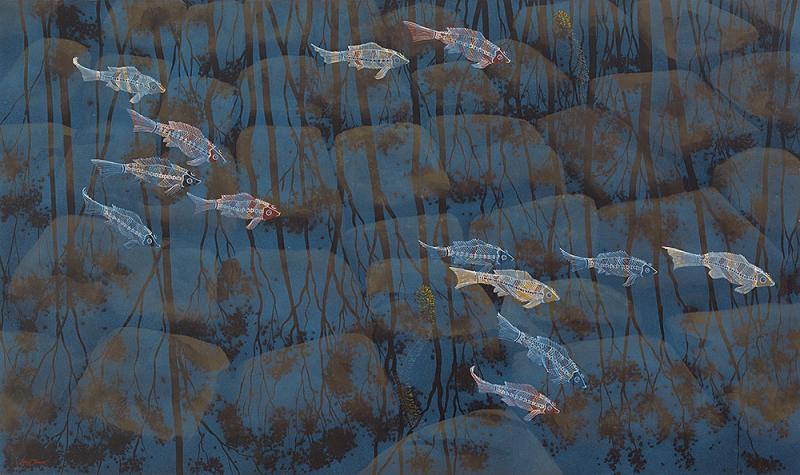LIN ONUS (1948-1996)
Untitled c1992
Estimate: $150000 - 180000
Description
LIN ONUS (1948-1996)
Yorta Yorta language group
Untitled c1992
synthetic polymer paint on canvas
91.0 x 152.0 cm
signed lower left: Lin Onus
Provenance:
Dreamtime Museum, Victoria
Private collection, Melbourne
Reference:
Neale, M., Urban Dingo, Craftsman House, Sydney, 2000, p.141
Estimate: $150000 - 180000
Lin Onus’ painting career began during the 1970s, coinciding with the acknowledgment of Aboriginal art in Australia and the emergence of the political debate on issues of native land rights and equal opportunity. Straddling dualistic perspectives through his art – one Western and representational, the other Aboriginal and spiritual – Onus explored issues of relevance to all Australians; reconciling cultural differences through ‘a sense of spanning the divides’. As the artist himself observed, ‘I hope that history may see me as some sort of bridge between cultures.’1
A pivotal moment in Onus’ life occurred in 1986 when, during a visit to Maningrida in Arnhem Land, his outlook on painting substantially shifted. His adoption by Arnhem Land Elders gave him the right to depict certain traditional stories and designs, and he began to portray figurative elements in a traditional form within a photorealist landscape. One critic commented at the time that in Onus’ work ‘landscape art is no longer an unconscious carrier of myths of domination…[it] demands the artist deconstruct in some manner these approaches and display an awareness of history and ideology’.2 Onus was acutely aware of the desire amongst non-Aboriginal viewers to understand the meaning of the concept of ‘the Dreaming’. The present work is a good example of Onus’ ability to impart his knowledge and to convey that beyond the immediately apparent, there is another dimension, a Dreaming reality that anyone can become aware of; if they are open to its presence.
Onus was a master at subverting Western perceptions of Indigenous art with subtlety and sophistication. By combining personal experience with shared stories, he imbued his work with a sense of familiarity, ensuring its appeal to a wider audience. Occupying an in-between space between multiple worlds, Onus was afforded the rare opportunity ‘to glimpse through many slightly ajar doors’ – paradoxically belonging everywhere, and nowhere. As Margo Neale elaborates in the catalogue accompanying the artist’s retrospective at the Queensland Art Gallery, ‘...his works are like the tales of a roving storyteller or mythmaker.’3
Of particular relevance to his ‘water and reflection’ paintings were Onus’ regular spiritual pilgrimages to Arnhem Land which, he later mused, ‘[gave him] back all the stuff that colonialism has taken away.’4 As Neale observed, ‘...now, in addition to his own ancestral site at Barmah Forest he was permitted to access new sites of significance such as Arafura Swamp, or his adoptive community at the outstation Garmedi; to kinship systems in which he and his family were assigned skin names; to language that he used for many of the titles of his works; to ceremony and Dreaming stories.’5 Arguably most influential upon his stylistic evolution, however, was the relationship he developed in Arnhem Land with the Aboriginal painter Jack Wunuwun. Inspired by the Elder’s bark painting techniques such as rarrk (cross-hatched designs), Onus embarked upon his celebrated series of watery landscapes which, rich in reflections and ambiguities, substituted the traditional European panoramic view for one described by Wunuwun as ‘seeing below
the surface.’
The present painting encapsulates Onus’ desire to create an art that could be appreciated on numerous levels by everyone, not just an elite few. In exploring the deeper significance of such works Neale wrote ‘…they are deceptively picturesque… laden with cross-cultural references, visual deceits, totemic relationships and a sense of displacement… they, amongst other things, challenge one’s viewing position.’6
Footnotes
1. Onus cited in Neale, M., Urban Dingo: The Art and Life of Lin Onus 1948 – 1996, Queensland Art Gallery, 2000, p.21
2. Radok, S., ‘The Sublime and the Parochial: the Foot of God’, 1997, Artlink, v. 17,
no. 3, p.16
3. Onus cited in Neale, M., Urban Dingo: The Art and Life of Lin Onus 1948 – 1996, Queensland Art Gallery, 2000, p.18
4. Ibid., p.15
5. Ibid., pp.15-16
6. Neale, M., quoted in Lin Onus, exhibition catalogue, Savill Galleries, Melbourne, 2003, p.1
Tracy Le Cornu BA (Hons)
Location
SYDNEY VIEWING. 17 - 20 October 11am - 6pm. 12 Todman Avenue, Kensington
MELBOURNE VIEWING. 24 - 30 October 11am - 6pm. Stonnington Mansion, 336 Glenferrie Rd, Malvern
